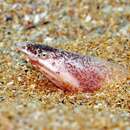en
names in breadcrumbs


Apterichtus caecus, the European finless eel, is a species of snake eel native to the eastern Atlantic Ocean, from the Azores to the Gulf of Guinea, and into the western Mediterranean including the Balearic Islands. It can be found on the continental shelf at depths of from 10 to 40 metres (33 to 131 ft) living in burrows in mud or sand. It preys on other fishes as well as benthic invertebrates. Spawning for this species in the Mediterranean has been recorded in the early summer months of May and June. This species can reach a length of 60 centimetres (24 in) TL.[3]
Apterichtus caecus, the European finless eel, is a species of snake eel native to the eastern Atlantic Ocean, from the Azores to the Gulf of Guinea, and into the western Mediterranean including the Balearic Islands. It can be found on the continental shelf at depths of from 10 to 40 metres (33 to 131 ft) living in burrows in mud or sand. It preys on other fishes as well as benthic invertebrates. Spawning for this species in the Mediterranean has been recorded in the early summer months of May and June. This species can reach a length of 60 centimetres (24 in) TL.
Apterichtus caecus es una especie de pez anguiliforme de la familia Ophichthidae[3] oriunda del este del océano Atlántico, incluyendo las islas Baleares, el oeste del mar Mediterráneo, las Azores y el golfo de Guinea.[2]
Habita en la plataforma continental, a profundidades de entre 10 y 40 m viviendo en lodo o arena. Se alimenta de otros peces, así como invertebrados bentónicos. El desove en el Mediterráneo se produce entre los meses de verano, a principios de mayo y junio. Esta especie puede alcanzar un largo total de 60 cm.[1]
Apterichtus caecus es una especie de pez anguiliforme de la familia Ophichthidae oriunda del este del océano Atlántico, incluyendo las islas Baleares, el oeste del mar Mediterráneo, las Azores y el golfo de Guinea.
Habita en la plataforma continental, a profundidades de entre 10 y 40 m viviendo en lodo o arena. Se alimenta de otros peces, así como invertebrados bentónicos. El desove en el Mediterráneo se produce entre los meses de verano, a principios de mayo y junio. Esta especie puede alcanzar un largo total de 60 cm.
Apterichtus caecus Apterichtus generoko animalia da. Arrainen barruko Ophichthidae familian sailkatzen da.
Apterichtus caecus Apterichtus generoko animalia da. Arrainen barruko Ophichthidae familian sailkatzen da.
L'Apterichtus caecus, noto come biscia di mare cieca o biscia di mare nuda in italiano, è un pesce osseo marino della famiglia Ophichthidae.
Questa specie è presente nel mar Mediterraneo e nell'Oceano Atlantico orientale tra il golfo di Guascogna e le coste dell'Africa tropicale. È presente in tutti i mari italiani ma più rara di Dalophis imberbis.
Vive su fondali sabbiosi costieri, a partire da pochi metri di profondità fino a poche decine.
Questo pesce è molto simile ad Dalophis imberbis ed ha un aspetto ancora più vermiforme essendo del tutto sprovvisto di pinne ed avendo un corpo molto sottile a sezione rotonda. L'occhio è piccolissimo ma, a dispetto sia del nome scientifico che di quello comune, questo animale ha la vista normalmente funzionante. La bocca è molto profonda. La punta della mandibola a bocca chiusa è all'altezza dell'occhio (al contrario che in D. imberbis), l'occhio più vicino alla punta del muso che all'angolo dell'apertura boccale.
La colorazione del pesce vivo non è molto nota, si crede comunque che sia brunastra rossiccia con macchie scure.
Misura fino a 60 cm, di solito molto meno.
In tutto simile a quella di D. imberbis alla cui voce si rimanda.
Carnivora.
Come nella biscia di mare le uova e le larve sono pelagiche ma si trovano in superficie in primavera. La larva è un leptocefalo.
Occasionale con reti a strascico e lenze.
La carne, commestibile ma ricca di lische, non ha alcun valore sui mercati.
Nota in passato con i sinonimi di Caecula caeca e Sphagebranchus caecus.
Apterichtus anguiformis (Peters, 1877), nota in italiano come biscia di mare minore, è molto simile ad A. caecus ma ha l'occhio (che è ancora più piccolo, quasi invisibile) alla stessa distanza dalla punta del muso e l'angolo della bocca, inoltre le parti terminali di mandibola e mascella sono neri. È presente nel mar Mediterraneo occidentale, comprese le acque italiane, e nell'Oceano Atlantico sulle coste marocchine. Si sa poco della biologia di questa specie, a lungop confusa con A. caecus.
L'Apterichtus caecus, noto come biscia di mare cieca o biscia di mare nuda in italiano, è un pesce osseo marino della famiglia Ophichthidae.
Apterichtus caecus is een straalvinnige vissensoort uit de familie van slangalen (Ophichthidae).[2] De wetenschappelijke naam van de soort is voor het eerst geldig gepubliceerd in 1758 door Linnaeus.
Bronnen, noten en/of referenties